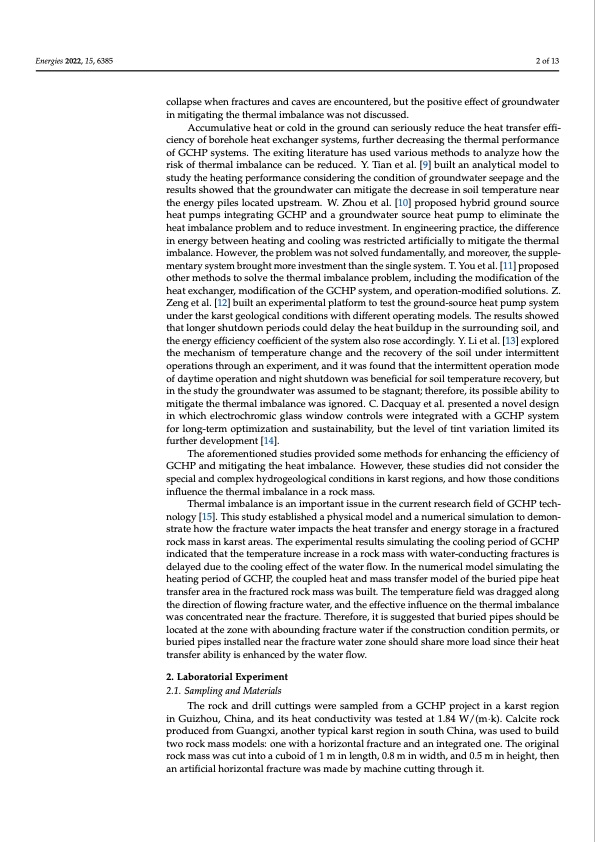
PDF Publication Title:
Text from PDF Page: 002
Energies 2022, 15, 6385 2 of 13 collapse when fractures and caves are encountered, but the positive effect of groundwater in mitigating the thermal imbalance was not discussed. Accumulative heat or cold in the ground can seriously reduce the heat transfer effi- ciency of borehole heat exchanger systems, further decreasing the thermal performance of GCHP systems. The exiting literature has used various methods to analyze how the risk of thermal imbalance can be reduced. Y. Tian et al. [9] built an analytical model to study the heating performance considering the condition of groundwater seepage and the results showed that the groundwater can mitigate the decrease in soil temperature near the energy piles located upstream. W. Zhou et al. [10] proposed hybrid ground source heat pumps integrating GCHP and a groundwater source heat pump to eliminate the heat imbalance problem and to reduce investment. In engineering practice, the difference in energy between heating and cooling was restricted artificially to mitigate the thermal imbalance. However, the problem was not solved fundamentally, and moreover, the supple- mentary system brought more investment than the single system. T. You et al. [11] proposed other methods to solve the thermal imbalance problem, including the modification of the heat exchanger, modification of the GCHP system, and operation-modified solutions. Z. Zeng et al. [12] built an experimental platform to test the ground-source heat pump system under the karst geological conditions with different operating models. The results showed that longer shutdown periods could delay the heat buildup in the surrounding soil, and the energy efficiency coefficient of the system also rose accordingly. Y. Li et al. [13] explored the mechanism of temperature change and the recovery of the soil under intermittent operations through an experiment, and it was found that the intermittent operation mode of daytime operation and night shutdown was beneficial for soil temperature recovery, but in the study the groundwater was assumed to be stagnant; therefore, its possible ability to mitigate the thermal imbalance was ignored. C. Dacquay et al. presented a novel design in which electrochromic glass window controls were integrated with a GCHP system for long-term optimization and sustainability, but the level of tint variation limited its further development [14]. The aforementioned studies provided some methods for enhancing the efficiency of GCHP and mitigating the heat imbalance. However, these studies did not consider the special and complex hydrogeological conditions in karst regions, and how those conditions influence the thermal imbalance in a rock mass. Thermal imbalance is an important issue in the current research field of GCHP tech- nology [15]. This study established a physical model and a numerical simulation to demon- strate how the fracture water impacts the heat transfer and energy storage in a fractured rock mass in karst areas. The experimental results simulating the cooling period of GCHP indicated that the temperature increase in a rock mass with water-conducting fractures is delayed due to the cooling effect of the water flow. In the numerical model simulating the heating period of GCHP, the coupled heat and mass transfer model of the buried pipe heat transfer area in the fractured rock mass was built. The temperature field was dragged along the direction of flowing fracture water, and the effective influence on the thermal imbalance was concentrated near the fracture. Therefore, it is suggested that buried pipes should be located at the zone with abounding fracture water if the construction condition permits, or buried pipes installed near the fracture water zone should share more load since their heat transfer ability is enhanced by the water flow. 2. Laboratorial Experiment 2.1. Sampling and Materials The rock and drill cuttings were sampled from a GCHP project in a karst region in Guizhou, China, and its heat conductivity was tested at 1.84 W/(m·k). Calcite rock produced from Guangxi, another typical karst region in south China, was used to build two rock mass models: one with a horizontal fracture and an integrated one. The original rock mass was cut into a cuboid of 1 m in length, 0.8 m in width, and 0.5 m in height, then an artificial horizontal fracture was made by machine cutting through it.PDF Image | Research on the Application of Fracture Water

PDF Search Title:
Research on the Application of Fracture WaterOriginal File Name Searched:
energies-15-06385.pdfDIY PDF Search: Google It | Yahoo | Bing
Turbine and System Plans CAD CAM: Special for this month, any plans are $10,000 for complete Cad/Cam blueprints. License is for one build. Try before you buy a production license. More Info
Waste Heat Power Technology: Organic Rankine Cycle uses waste heat to make electricity, shaft horsepower and cooling. More Info
All Turbine and System Products: Infinity Turbine ORD systems, turbine generator sets, build plans and more to use your waste heat from 30C to 100C. More Info
CO2 Phase Change Demonstrator: CO2 goes supercritical at 30 C. This is a experimental platform which you can use to demonstrate phase change with low heat. Includes integration area for small CO2 turbine, static generator, and more. This can also be used for a GTL Gas to Liquids experimental platform. More Info
Introducing the Infinity Turbine Products Infinity Turbine develops and builds systems for making power from waste heat. It also is working on innovative strategies for storing, making, and deploying energy. More Info
Need Strategy? Use our Consulting and analyst services Infinity Turbine LLC is pleased to announce its consulting and analyst services. We have worked in the renewable energy industry as a researcher, developing sales and markets, along with may inventions and innovations. More Info
Made in USA with Global Energy Millennial Web Engine These pages were made with the Global Energy Web PDF Engine using Filemaker (Claris) software.
Sand Battery Sand and Paraffin for TES Thermo Energy Storage More Info
| CONTACT TEL: 608-238-6001 Email: greg@infinityturbine.com | RSS | AMP |